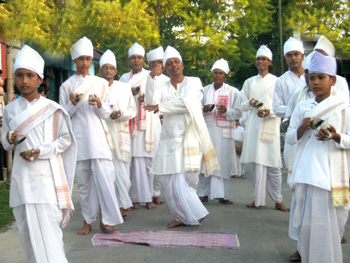The various ethnic groups of Assam have their own unique dances. These include the Bodo’s Bihu Dance, the Bodo’s Bagurumba Dance, the Mishing’s Ali Al Ligang, and the Barpeta’s Bhortal Nritya. These dances have been practiced for thousands of years, and many people take great pride in their traditional costumes and music.
Bihu Dance

The Rongali Bihu Dance of Assam has become a cultural highlight in the state. It is performed by women in groups and involves a series of different movements. Women perform this dance by bending their waists, opening their shoulders, placing their feet apart, and singing. The costumes of the performers are colorful and include heavy jewellery and flower-adorned plaits. During the performance, the audience can witness the dancing women’s stunning beauty.
The Bihu dance is performed by people of different ethnic groups in the state of Assam. This dance is considered a part of the culture of Assam and is performed to celebrate the arrival of spring. Today, professional dancers perform the dance for audiences across the world. The Rongali Bihu festival, one of three celebrated in the state, has become a popular international event. The dance has gained a worldwide following, with dancers performing it for celebrities in London in 2012.
Bodo’s Bagurumba Dance
Bodos perform the traditional Bagurumba dance in Assam, India, during festivals to welcome spring. It is also known as the butterfly dance and is performed during Bwishagu, a Bodo festival celebrated around Bishuba Sankranti in mid-April. In this dance, the young people bow down to their elders and parents in reverence. It is performed by male and female members of the community.
Bodos are a tribal ethnic group and are close to rivers. The Bodo Bagurumba dance is a ritualistic tribute to a deity in the Bodo community. This traditional dance is performed with vigor and craft and is one of the most beautiful events in the life of the Bodo people. It is a cultural highlight for many visitors to Assam.
Mishing’s Ali Al Ligang
One of the most important festivals in Assam is the Mishing Ali ai Ligang, which means “root and seed” in English. The festival is celebrated by the young Mishing Tribe every year on the first Wednesday of the month of Ginmur Polo. It is the first day of paddy sowing in the region, and the festival is one of the most colourful and energetic events of the year. The festival is celebrated with fast-paced stepping, flinging, and hand movements that are reminiscent of traditional Chinese and Tibetan dances.
The Misings, also known as the Miri tribe, practice joint family structures. The eldest family member is considered to be the most respected. This patriarchal society is centered around agriculture and fishing, and their celebrations revolve around these activities. The Mishing people are highly dependent on fishing and agriculture for their livelihood, and these seasons are the theme of their celebrations. During harvest season, the Mishings perform a ceremony that is known as’sowing seeds’. This festival is held on the first Wednesday of Ginmur Polo, which is in February-March in the Gregorian calendar.
Barpeta’s Bhortal Nritya
The Bhortal Nritya is a dance form that has a rich heritage in the Assamese state of Tripura. This dance form features highly energetic and expressive movements that reflect the state’s rich culture. It is usually performed by groups of 6-7 dancers. The dancers beat on cymbals in a rhythmic manner and create beautiful patterns with their movements.
This dance form originated from the renowned Satriya artist, Narahari Burha Bbakat. The ‘Zhiya Nom’ rhythm accompanied by the flamboyant gestures and fast-paced cymbal percussions make for an exciting show. This dance is one of Assamese traditions that are a must-see! Here are some facts about Barpeta’s Bhortal Nritya:
Tea Folk’s Jhumur Nach

The tea folk of Assam have a unique and fascinating dance form that has a rich history dating back hundreds of years. The Jhumur Nach is a tribal dance performed by young women during festivals and harvest time. This dance form is primarily performed during the Karam puja festival, which is a week-long celebration dedicated to the god Karam. It incorporates songs and dances as part of the worship of the god.
The dance is accompanied by the Madal, a two-headed hand drum. The dancers step in perfect timing and accuracy. The enchanting music and precise footwork are sure to make any audience feel the heart of the Assamese tea culture. During the rainy harvest season, the Jhumur Nach is most enchanting. Tea garden workers in Assam earn their livelihood from the tea plants, and this cultural dance is an integral part of their daily life.
Xattriya Dance
Xattriya is another Assamese dance form. Its roots are in religion and was originally performed by celibate male monks in the state’s monasteries. It has been adapted for stage performances, and despite its importance, a majority of the academic world is unaware of its history. It was initiated by Mahapurush Srimanta Shankardev, a Vaishnavite saint. This saint was a composer, poet, and a multi-talented artist. He helped usher in a new cultural renaissance in Assam
Ola Pali Dance

The classical dance of Assam is known as Oja-Pali, which is performed by a group of chorus singers and dancers. The dancers follow a leader, who is called a Pali. Other Palis are assistants, who assist the principal Pali. The dance relates mythology and lessons learned from the various mythologies.
Deodhani
Another Assamese dance is the Deodhani, performed by a single dancer or a group of three or four women. It is performed in honor of the snake goddess Manasa. The dance is often performed to the accompaniment of songs sung by an oja, an Assamese traditional chorus leader. It depicts a strong and unmarried woman.
